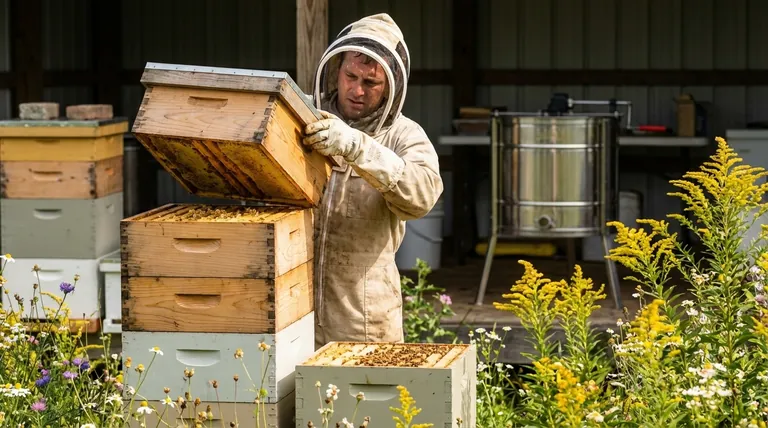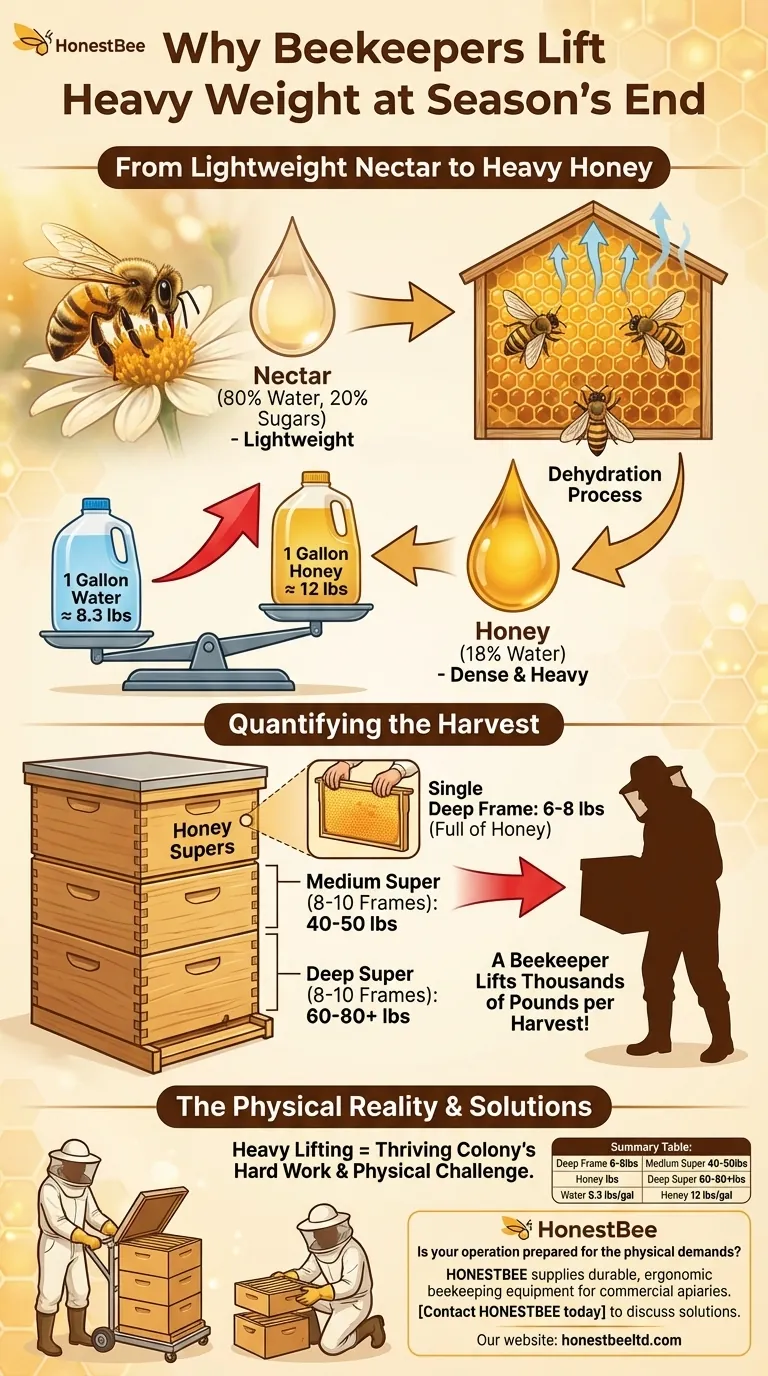At the end of a growing season, beekeepers face significant heavy lifting because their bee colonies have successfully converted lightweight floral nectar into dense, heavy honey. This accumulated honey, stored in hive boxes called "supers," can make a single box weigh upwards of 50 to 80 pounds, and a beekeeper must lift many of these to complete a harvest.
The immense weight a beekeeper lifts is not just a burden; it is the physical proof of a thriving colony's hard work. The entire process is a transformation of a lightweight liquid into a dense, energy-rich food source.

From Lightweight Nectar to Heavy Honey
The primary reason for the weight gain is a natural process of dehydration and chemical conversion managed entirely by the honeybees.
The Starting Point: Floral Nectar
Nectar, the raw material for honey, is surprisingly lightweight. It is composed of roughly 80% water and only 20% complex sugars.
Bees collect this nectar from flowers and transport it back to the hive in a specialized stomach.
The Dehydration Process
Inside the hive, bees work to transform nectar into honey. They pass the nectar from bee to bee, adding enzymes that break down complex sugars into simpler ones.
Crucially, they deposit the nectar in wax honeycomb cells and fan it with their wings. This evaporates the excess water, reducing the water content from 80% down to about 18%.
The Result: Dense, Heavy Honey
This drastic reduction in water content is what makes honey so dense and heavy. Honey is significantly heavier than the volume of water it displaces.
A gallon of water weighs about 8.3 pounds, while a gallon of honey weighs approximately 12 pounds. This density is the core reason the hive's weight increases so dramatically.
Quantifying the Weight of a Harvest
To understand the physical task, we need to look at the components a beekeeper lifts. A modern beehive is a stack of boxes, and the top boxes, or "supers," are designated for honey storage.
The Weight of a Single Frame
A super is filled with removable frames where bees build their wax comb and store honey. A single "deep" frame, when completely full of cured honey, can weigh between 6 to 8 pounds.
The Weight of a Honey Super
A standard super holds 8 to 10 of these frames. When full, a medium-sized super can weigh 40-50 pounds, while a deep super can easily exceed 80 pounds.
A productive hive may have two, three, or even more of these supers stacked on top of it, all of which must be lifted and removed by the beekeeper.
The Physical Reality of a Good Harvest
The heavy lifting is a sign of success, but it presents a significant physical challenge that every beekeeper must manage.
Why Harvest at This Time?
The end of the main growing season, often in late summer or early fall, is when nectar sources dwindle. This signals to the beekeeper that the bees have stored the maximum amount of surplus honey they are going to produce for the year.
The Demands of the Job
A beekeeper with multiple hives may need to lift thousands of pounds in a single day. This repetitive, heavy lifting poses a risk of back and muscle strain.
To manage this, beekeepers often use smaller, lighter boxes (medium supers instead of deep ones) or employ specialized equipment like hive lifts. However, for most hobbyists and small-scale beekeepers, the work is done by hand.
Applying This Understanding
Thinking about the weight provides a direct connection to the work required to produce the honey we consume.
- If your goal is to appreciate local food: Recognize that the weight of a jar of honey represents the final, concentrated product of thousands of bees' flights and a beekeeper's intense physical labor.
- If you are considering beekeeping: Be prepared for the physical demands, especially during a successful harvest, and plan your equipment choices accordingly to protect your body.
Ultimately, the heavy lifting at the end of the season is the beekeeper's reward for a year of careful hive management.
Summary Table:
| Harvest Component | Approximate Weight | Key Detail |
|---|---|---|
| Single Deep Frame | 6 - 8 lbs | Filled with cured honey and wax comb. |
| Medium Honey Super (8-10 frames) | 40 - 50 lbs | A lighter, more manageable box option. |
| Deep Honey Super (8-10 frames) | 60 - 80+ lbs | The standard, heavier box for maximum honey storage. |
| Water vs. Honey (per gallon) | 8.3 lbs vs. 12 lbs | Highlights the density gained from dehydration. |
Is your operation prepared for the physical demands of a successful harvest? At HONESTBEE, we supply commercial apiaries and distributors with durable, ergonomic beekeeping equipment designed to handle heavy loads and protect your most valuable asset: your team. From lightweight supers to harvesting tools, our wholesale-focused solutions help you manage the reward of a heavy harvest efficiently and safely.
Contact HONESTBEE today to discuss equipment solutions for your commercial beekeeping needs.
Visual Guide

Related Products
- HONESTBEE 72 Frame Industrial Electric Honey Extractor for Beekeeping
- 2 Frame Stainless Steel Manual Honey Spinner Extractor for Beekeeping
- HONESTBEE 3-Frame Manual Acrylic Honey Extractor
- electric honey extractor honey centrifuge 3 frame honey extractor stainless steel honey frame extractor
- 40 Frame Commercial Electric Honey Extractor for Beekeeping
People Also Ask
- Can a manual extractor be upgraded to an electric one? Save Labor & Boost Efficiency
- What are the two common types of honey extractors? Choose the Right Extractor for Your Apiary
- What should a beekeeper do after extracting honey from supers? A Guide to Harvest Management
- What are the advantages of automatic honey extractors? Scale Your Apiary with Unmatched Efficiency
- How is honey harvested from Langstroth hives? A Guide to Efficient, Comb-Preserving Extraction



















